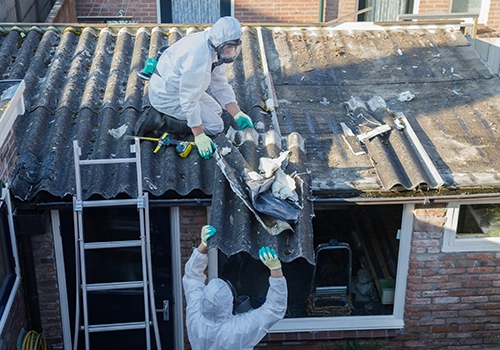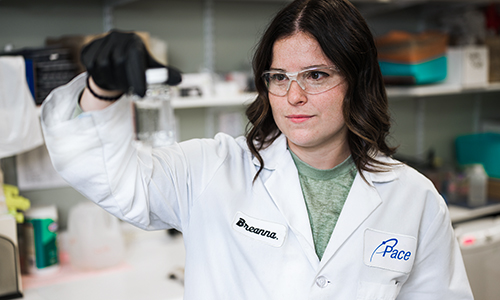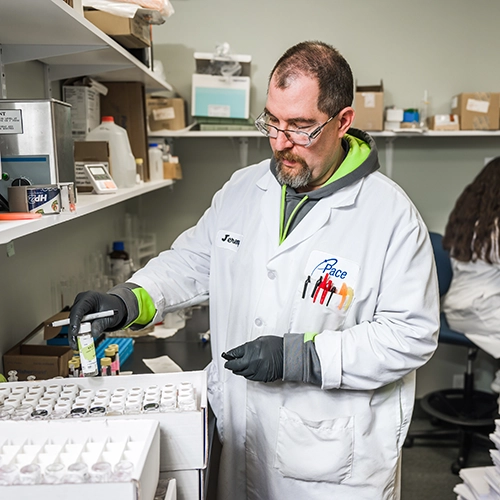What Is Asbestos?
People have used asbestos, a naturally occurring mineral, for centuries because of its unique properties. The term “asbestos” refers to six regulated, naturally occurring fibrous silicate minerals: chrysotile, amosite, crocidolite, anthophyllite, tremolite, and actinolite.
Asbestos consists of long, thin fibers. These fibers are exceptionally strong, flexible, and resistant to heat, fire, and chemicals. These qualities made asbestos an ideal material for insulation, fireproofing, and soundproofing in buildings, ships, and other structures.
Manufacturers used it in many products. These include cement, plastics, flooring, paper, textiles, and automotive parts like brakes and clutches.
CONTACT PACE® ABOUT
ASBESTOS TESTING SERVICES

How Does Asbestos Exposure Occur?
When someone disturbs materials with asbestos, tiny fibers can escape into the air. This can happen during product use, home maintenance, repairs, demolition, or remodeling. Damaging or disturbing these materials releases particles and fibers into the air. When asbestos fibers become airborne, individuals in the vicinity can inhale them, posing a health risk.
How Asbestos Is Identified
Asbestos cannot be identified visually. Testing for the presence or contamination is the only way to confirm the presence of asbestos. Pace® offers direct access to our asbestos subject matter experts! If you suspect asbestos
How is Asbestos Regulated?
Asbestos regulation in the United States is a complex process. It involves the EPA (Environmental Protection Agency) and OSHA (Occupational Safety and Health Administration). The EPA is primarily concerned with environmental protection, while OSHA focuses on ensuring safety in the workplace.
Additionally, individual states may implement their own regulations, which are often more stringent. States usually manage and enforce federal rules like AHERA (Asbestos Hazard Emergency Response Act) and NESHAP. They can also choose to enforce OSHA standards for worker safety.

On-Demand Webinar: Asbestos in settled dust
Asbestos Containing Materials (ACM) were widely used in US building materials and consumer products. ACMs undergoing disturbance and aging can release asbestos debris and dust. This can re-entrain into indoor air, causing exposure.
Pace® provides end-to-end support for various projects that require asbestos testing.
Asbestos in settled dust
Which Method Should You Use?
Download our new Pace® Info Sheet for a comprehensive look at:
- Collection Methods
- Various Analysis Options
- The Advantages and Disadvantages of Each Approach
WHO WE SERVE

Building renovation and demolition can easily disturb known and unknown asbestos-containing materials (ACMs). Learn how Pace ® can help.
When there is suspicion of asbestos, consultants perform inspections. They prepare and oversee abatement and remediation planning, and perform clearance testing.
Scientists and engineers are committed to protecting the health and safety of people in the workplace and the community. Asbestos testing and exposure assessments may be part of their primary responsibilities.
Regulation requires qualified abatement contractors remove the asbestos. If removal is impossible or impracticable, contractors mitigate the issue for anyone who lives or works in the building.
Failure to reveal the presence of asbestos materials to buyers and tenants could lead to litigation. This is especially important for real estate sellers, landlords, and property managers.
Homes and residential buildings built prior to 1980, have a higher chance of facing asbestos containing products. Many home construction materials once contained asbestos. Exposure to asbestos fibers could increase the likelihood of long term lung disease.
Why Select Pace®
We are the largest American-owned environmental lab in North America. Pace® has a well-established reputation for delivering fast, reliable analytical services to a wide range of customers. This includes industrial hygienists, environmental and engineering consultants, construction and real estate industries, abatement contractors and homeowners. By leveraging our expertise, advanced analytical techniques, and cutting-edge instrumentation, we ensure that the data generated is accurate, reliable, and defensible.
For over 30 years, Pace® has tested for asbestos in air, water, soil, dust, and bulk samples. Our accredited asbestos laboratories can provide isolation and identification of the six regulated asbestos forms in bulk materials and soils including:
- Chrysotile (white)
- Amosite (brown)
- Crocidolite (blue)
- Fibrous Anthophyllite
- Fibrous Tremolite
- Fibrous Actinolite
Pace also provides advanced asbestos testing in consumer products, such as cosmetic products. We offer testing for non-regulated amphiboles (NRAs), natural occurrences of asbestos (NOAs), and asbestiform talc.
CONTACT US ABOUT
ASBESTOS TESTING TODAY.
Additional Resources
Need to find a lab that can handle your unique requirements?
Contact us directly or download our list of environmental certifications across our network.
eBook: Asbestos "The Invisible Enemy"
SOQ: Building Sciences Statement Of Qualifications (SOQ)
Info Sheet: Asbestos in Settled Dust
Info Sheet: Asbestos Testing
On-Demand Webinar: Asbestos in Settled Dust